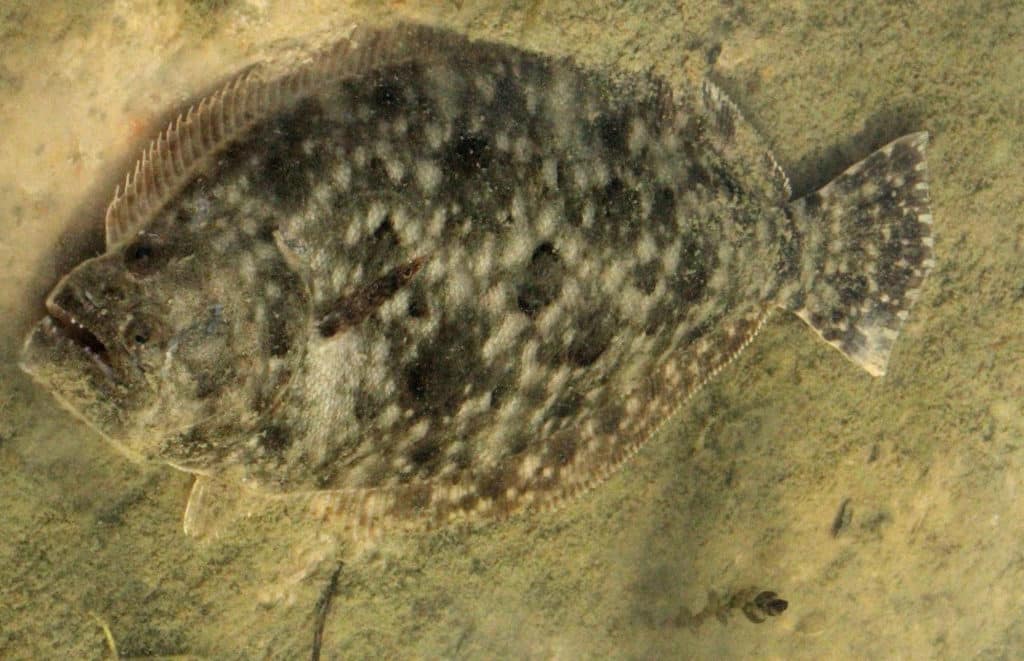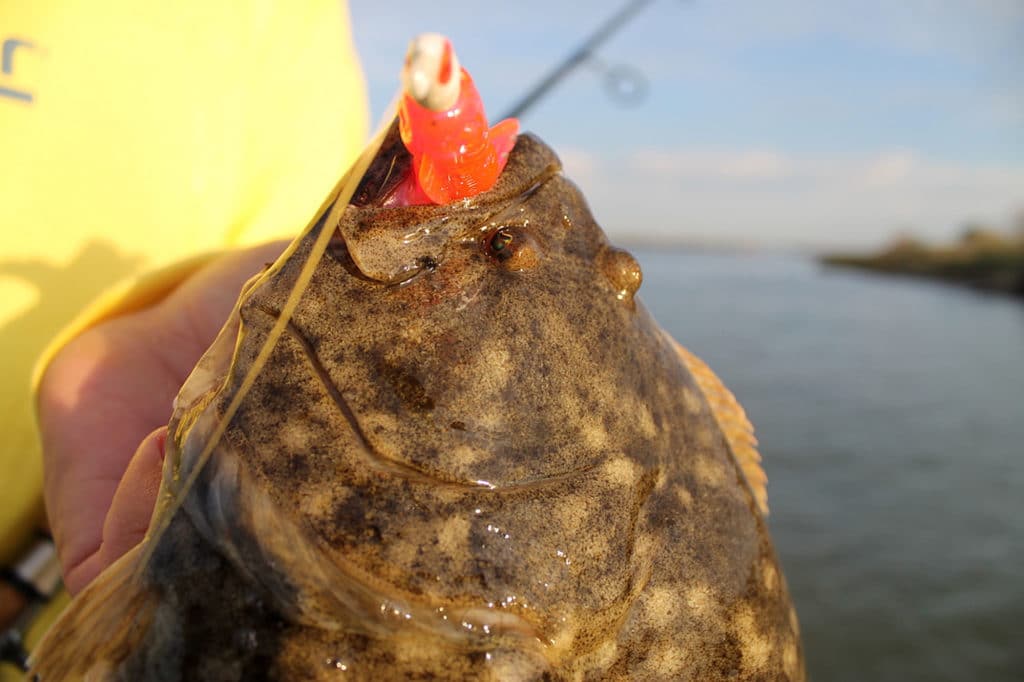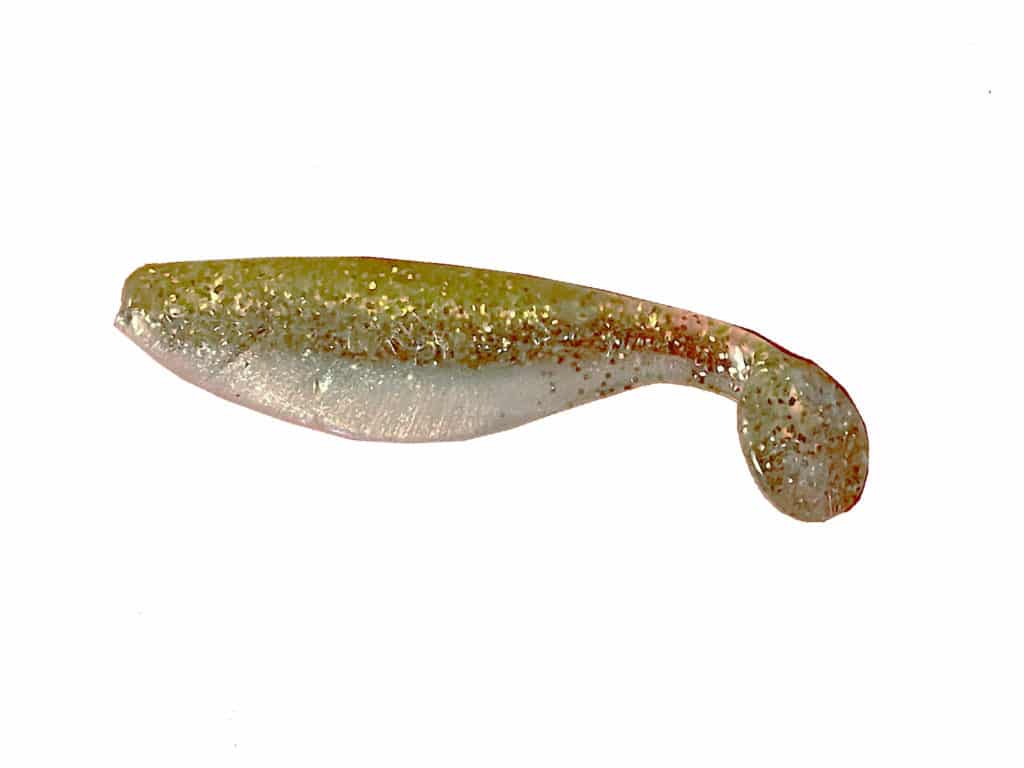
The water along the upper Texas coast usually stays too murky for sightfishing, but on this particular late fall day, it looked crystal clear in the tiny canal that runs along Highway 87 in Bridge City. I saw flounder everywhere.
I could see some as sandy outlines on the bottom; others aggressively blasted toward the surface, feeding on shrimp. Certainly, this would be a flounder fisherman’s dream come true.
Not so. I offered multiple baits as I walked along the canal’s edge. The flounder refused all of them.
Something New
Having just returned from a crappie-fishing expedition, I still had a medium-light-action spinning rod rigged with fluorocarbon line and a 2-inch curl-tailed grub in the back of my truck. A curl tail is my favorite flounder lure but this one was half the size of my normal presentation.
Out of desperation, I walked back to the truck and grabbed the rig. Then, I waited for one of the feeding flounder to move. The first cast produced nothing. But the second one scored and so did the third. By the end of the day, I had released 17 flounder.
That unexpected windfall happened in late November, just after the peak of the fall flounder migration into the Gulf of Mexico. On that day I learned a valuable lesson that allowed me to score on quality flounder during the run as well as successfully extend fishing efforts into the winter.

Elephants Eat Peanuts
A few years back, a gentleman named Ben Jarrett outfished me on a redfish trip by using a tiny topwater when I was throwing a super-size Super Spook.
“Elephants eat peanuts,” he said, echoing the familiar expression. To this day that serves as a reminder that sometimes I need to downsize gear to catch big fish.
While big flounder sometimes eat large mullet, they seem just as satisfied eating 100 tiny menhaden. They ambush prey, so they tend to feed on what the currents bring them. In the late fall and winter, that’s often tiny baitfish and crustaceans.
Lighter Tackle
My favorite rod for this application is a medium-action Abu Garcia Ike Dude combo spooled with 8-pound-test fluorocarbon line. Fluorocarbon features the same refractive properties as water, and is killer for catching flounder in clear water in particular. It also offers better abrasion resistance than monofilament.
For general flounder fishing, I actually prefer braided line, especially when pursuing big fish. I normally use 50-pound SpiderWire on medium-heavy-action rods. However, when using microplastics, I need a finesse approach.
Yes, I lose a few with the light tackle but I get far more bites than on the other rigs, starting about the third week in November through Valentine’s Day.

Plastic Preferences
My favorite micro lures include the 2-inch Mr. Twister Teenie (in pink for off-colored water or luminescent for clear water), and the Mr. Twister Sassy Shad in the 2.5-inch size and in clear silver-flake/black-back.
Mr. Crappie’s Shadpole Curlytail in the salt-and-pepper color and the Bobby Garland Baby Shad in the eclipse or hologram-ghost patterns also work. All of my small lures for flounder come from the freshwater world, which shows we should not limit ourselves to a particular section of the tackle shop.
If the water looks dingy, fish obnoxious colors like pink but if it’s clear, use natural colors. Flounder are very visual fish and sensitive to tiny changes in water clarity and lure-color presentation.
I rig small plastics on a 1/16-ounce jighead and crawl them slowly across the bottom. If you feel a hard “thump,” count to two and set the hook. If you feel a slight tap on the line, wait about 10 seconds and then set the hook. Sometimes flounder simply grab a lure and hold on. Give them a few moments to move the lure inside their mouths.

Finding Flounder
To target late-season flounder, look for canals and shorelines that provide the fish with quick access to deep water. When temperatures fall, these holdover flounder move into deeper, warmer water but come back shallow to feed as temperatures rise. Generally speaking, the southern half of a bay system and channels leading to the Gulf produce best.
When you start hearing about anglers catching big trout along the spoils in ship channels and around deep-water drop-offs, go to those same locations and look for flounder. Both species seem to move from deep to shallow water at similar times.
When south winds push slightly warmer water in from the Gulf, fish the rising tide for good action. Slight variations in temperature can make a huge difference to flounder. Any south-facing shoreline can also be good on days with strong wind because baitfish push up against the banks.
Read Next: More Flounder Fishing Tips
As fall segues into winter, fish slow. If you think you’re fishing too slow, you’re probably not fishing slow enough. Start with a super-slow approach, and then if you’re not getting bit, speed up.
The fish don’t scatter at this time of year, so locate fish and focus on an area with a high probability of catches. Once you establish a bite, fish slowly and be aware of their delicate strikes.

Save the Flatties
Flounder are super popular all along the Gulf Coast, but some issues have erupted for the stock due to rising Gulf water temperatures, commercial pressure, and other factors. In 2021 Texas instituted a closure to all flounder harvest from Nov. 1 to Dec. 14, making the fishery catch-and-release only during this time.
I release all flounder measuring 20 inches or more any time of year and recommend other anglers do the same. The greater number of big, breeding-size fish we put back, the better chance for quality flounder fishing in the future.
Due to the incredible taste of flounder, anglers generally consider them a prize for the table and don’t generally release them as they do snook or speckled trout. But flounder deserve the same respect. Keeping the smaller, legal-size fish to eat and releasing the big ones has worked for other species and can help ensure the future of the southern flounder.
In fact, you might earn a conservation-challenge coin if you release a flounder over 20 inches and capture proof. The flounder catch-and-release conservation program that I ran between 2008 to 2013 — Flounder Revolution — has been reborn with a new twist. This project includes anglers from Texas, Louisiana, Mississippi, Alabama, and Florida. The coins are our Flounder Revolution “Catch, Release & Conserve Award.”
Anglers who catch and release flounder 24 inches or better, we give another coin called the “Save the Saddle Blanket” award.
All anglers who enter fish also receive an entry for a special-prize drawing. One lucky angler will get a replica of their catch at the end of the year.
CCA-Texas is the official sponsor of Flounder Revolution’s awards. Visit flounderrevolution.com.
Chester Moore is an award-winning wildlife journalist and conservationist from Orange, TX. He has a lifelong passion for flounder fishing, and is the founder of the Flounder Revolution program. He was named a “Hero of Conservation” by Field & Stream magazine for his work with flounder and won the Mossy Oak Outdoors Legacy Award for his work with kids and wildlife. You can follow his work at highercalling.net.








